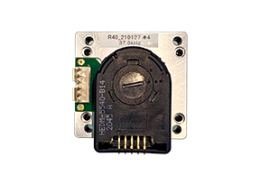ļØ╝ņØĖ


Piezoelectric Ultrasonic Motor of Rotary type
PUMR is a rotary motor developed by the piezoelectric technology. PUMR stands for Piezoelectric Ultrasonic Motor of Rotary Type.
The ultrasonic motor is composed of an elastic body, ring-type piezoelectric ceramic and a rotor.
Bonding a ring-type piezoelectric ceramic on the elastic body, the stator was made. To run the ultra-sonic motor, two driving signals
which are the sinusoidal waves having a 90 degree phase-difference must be needed.
When applying two signals, the stator will vibrate and makes the traveling wave on the elastic surface. It makes the rotor rotate.
Because the ultra-sonic motor does not use coils or magnets, it is very slim and also can be used in high magnetic field environment such as MRI.
The driving frequency of motor is more than 20kHz. Therefore it generates very low audible noise when running.
It is very useful feature in many commercial appliances.
The piezoelectric ceramic is a key element that generates ultrasonic vibration when a specific high frequency signals are applied.
At that time, the piezoelectric ceramic itself expands and contracts and the progressive wave travels along the circumstance of the stator.
Because the rotor and stator are pressed against each other with strong pressure so PUMR intrinsically has a high braking force when stopped.

The stator behaves as an elastic ring. The traveling wave over the stator surface creates elliptical motions.
The elliptical motions of the contact parts pushes the rotor and makes rotary motion.
The teeth of the stator are intended to be formed to amplify the displacements. The specification of the PUMR
depends on friction between the rotor and stator. The piezoelectric ceramic excites a traveling flexural wave on the stator.
And the ceramic of the active material leads to elliptical motion of the surface particles.
The frictional force between the stator and the rotor causes the rotor to spin. The frictional force is obtained by pressing the rotor on top of the stator

Low speed, High torque
Simple structure
Quick response
Low audible noise
Precise positioning
Intrinsic high braking torqueI
No EMI/RFI, None magnetic
ļ│Ėņé¼, Ļ│Ąņן : ņä£ņÜĖņŗ£ ņżæļ×æĻĄ¼ ļ┤ēĒÖöņé░ļĪ£123, ņŗĀļé┤ĒģīĒü¼ļģĖĒāĆņÜ┤ 501, 503ĒśĖ
Tel. 02 3421 0370 / Fax. 02 3421 0374
ĻĖ░ņłĀņŚ░ĻĄ¼ņåī : Ļ▓ĮĻĖ░ļÅä ļé©ņ¢æņŻ╝ņŗ£ ļ│äļé┤ņżæņĢÖļĪ£ 34 ļĪ£ļÄĆĒāĆņøī 801ĒśĖ
Fax. 031 572 0373
ņé¼ņŚģņ×Éļ▓łĒśĖ : 209-81-27115 / ļīĆĒæ£ : ņ£żņä▒ņØ╝
Ļ░£ņØĖņĀĢļ│┤ ļ│┤ĒśĖņĀĢņ▒ģCopyright(c) Piezo Electric Technology. All Rights Reserved.
Head office & Factory: #501,503 Sinnae Technotown, Bonghwasan-ro 123 Jungrang-gu, Seoul, 02048. KOREA
Tel. 02 3421 0370 / Fax. 02 3421 0374
R&D Center: #801 Rodem tower, Byeollaejungang-ro 34, Namyangju-Si, Gyeonggi-do, 12113. KOREA
Fax. 031 572 0373
Business registration number: 209-81-27115 / CEO: Seong-il, Yoon
Privacy policyCopyright(c) Piezo Electric Technology. All Rights Reserved.
